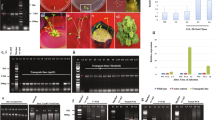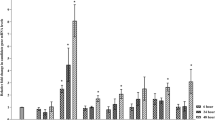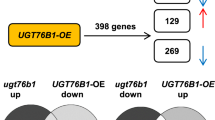Abstract
The Clp protease complex, which is the central protein degradation machinery in plastids, plays a role similar to proteasome. ClpC1 and ClpC2 comprise the chaperonic part of the Clp protease and share more than 90% nucleotide sequence similarity with each other. In a previous study, the co-suppression of Nicotiana benthamiana ClpC1 and ClpC2 (NbClpC1/C2) resulted in leaf chlorosis, growth retardation phenotype, disappearance of apical dominance and coarsely packed mesophyll cells. Quantitative real-time PCR analysis revealed that the co-suppression of NbClpC1/C2 upregulated the expression levels of defense-related genes including pathogenesis-related protein 1b (PR1b), glutathione-S-transferase, catalase, ascorbate peroxidase and systemic acquired resistance gene 8.2 (SAR8.2). NbClpC1/C2 co-suppressed leaves accelerated hypersensitive response by the infection with an incompatible pathogen, Pseudomonas syringae pv. tomato T1, but increased susceptibility via the infiltration of a compatible pathogen, P. syringae pv. tabaci. These findings indicate that disruption of the chaperones of ClpC1 and ClpC2 increases the growth of bacterial pathogens and therefore increases hypersensitive response and disease susceptibility.



Similar content being viewed by others
References
Able AJ, Guest DI, Sutherland MW (2000) Hydrogen peroxide yields during the incompatible interaction of tobacco suspension cells inoculated with Phytophthora nicotianae. Plant Physiol 124:899–910
Adam Z, Rudella A, van Wijk KJ (2006) Recent advances in the study of Clp, FtsH and other proteases located in chloroplasts. Curr Opin Plant Biol 9:234–240
Akita M, Nielsen E, Keegstra K (1997) Identification of protein transport complexes in the chloroplastic envelope membranes via chemical cross-linking. J Cell Biol 136:983–994
Ali MS, Kim KW, Dhakal R, Choi D, Baek K-H (2015a) Accumulation of high contents of free amino acids in the leaves of Nicotiana benthamiana by the co-suppression of NbClpC1 and NbClpC2 genes. Plant Cell Rep 34:355–365
Ali MS, Yu Y, Oh W, Cho JY, Choi J, Dhakal R, Park Y, Baek K-H (2015b) Co-suppression of NbClpC1 and NbClpC2 in Nicotiana benthamiana lowers photosynthetic capacity via altered leaf structure. Plant Omics 8:508–516
Alvarez ME, Pennell RI, Meijer PJ, Ishikawa A, Dixon RA, Lamb C (1998) Reactive oxygen intermediates mediate a systemic signal network in the establishment of plant immunity. Cell 92:773–784
Constan D, Froehlich JE, Rangarajan S, Keegstra K (2004) A stromal Hsp100 protein is required for normal chloroplast development and function in Arabidopsis. Plant Physiol 136:3605–3615
Flores-Pérez U, Jarvis P (2013) Molecular chaperone involvement in chloroplast protein import. Biochim Biophys Acta 1833:332–340
Garcia MX, Alexander H, Mahadeo D, Cotter DA, Alexander S (2003) The Dictyostelium discoideum prespore-specific catalase B functions to control late development and to protect spore viability. Biochim Biophys Acta 1641:55–64
Gechev TS, Hille J (2005) Hydrogen peroxide as a signal controlling plant programmed cell death. J Cell Biol 168:17–20
Kang S, Oh S-K, Kim J-J, Choi D, Baek K-H (2010) NMMP1, a matrix metalloprotease in Nicotiana benthamiana has a role in protection against bacterial infection. Plant Pathol J 26:402–408
Kim J, Rudella A, Rodriguez VR, Zybailov B, Olinares PDB, van Wijk KJ (2009) Subunits of the plastid ClpPR protease complex have differential contributions to embryogenesis, plastid biogenesis, and plant development in Arabidopsis. Plant Cell 21:1669–1692
Koussevitzky S, Stanne TM, Peto CA, Giap T, Sjogren LL, Zhao Y, Clarke AK, Chory J (2007) An Arabidopsis thaliana virescent mutant reveals a role for ClpR1 in plastid development. Plant Mol Biol 63:85–96
Kovacheva S, Bedard J, Patel R, Dudley P, Twell D, Rios G, Koncz C, Jarvis P (2005) In vivo studies on the roles of Tic110, Tic40 and Hsp93 during chloroplast protein import. Plant J 41:412–428
Kumar S, Trivedi PK (2018) Glutathione S-transferases: role in combating abiotic stresses including arsenic detoxification in plants. Front Plant Sci 9:1–9
Kuzniak E, Sklodowska M (2005) Fungal pathogen-induced changes in the antioxidant systems of leaf peroxisomes from infected tomato plants. Planta 222:192–200
Lee SC, Hwang BK (2003) Identification of the pepper SAR8.2 gene as a molecular marker for pathogen infection, abiotic elicitors and environmental stresses in Capsicum annuum. Planta 216:387–396
Moons A (2003) Osgstu3 and osgtu4, encoding tau class glutathione S-transferases, are heavy metal- and hypoxic stress induced and differentially salt stress-responsive in rice roots. FEBS Lett 553:427–432
Nielsen E, Akita M, Davila-Aponte J, Keegstra K (1997) Stable association of chloroplastic precursors with protein translocation complexes that contain proteins from both envelope membranes and a stromal Hsp100 molecular chaperone. EMBO J 16:935–946
Nishimura K, Apitz J, Friso G, Kim J, Ponnala L, Grimm B, van Wijk KJ (2015) Discovery of a unique Clp component, ClpF, in chloroplasts: a proposed binary ClpF-ClpS1 adaptor complex functions in substrate recognition and delivery. Plant Cell 27:2677–2691
Peltier JB, Ripoll DR, Friso G, Rudella A, Cai Y, Ytterberg J, Giacomelli L, Pillardy J, van Wijk KJ (2004) Clp protease complexes from photosynthetic and nonphotosynthetic plastids and mitochondria of plants, their predicted three dimensional structures, and functional implications. J Biol Chem 279:4768–4781
Pompe-Novaka M, Grudena K, Baeblera S, Kreçiç-Stresa H, Kovaça M, Jongsma M, Ravnikar M (2006) Potato virus Y induced changes in the gene expression of potato (Solanum tuberosum L). Physiol Mol Plant Pathol 67:237–247
Rosano GL, Bruch EM, Ceccarelli EA (2011) Insights into the CLP/HSP100 chaperone system from chloroplasts of Arabidopsis thaliana. J Biol Chem 286:29671–29680
Roxas VP, Smith RKJ, Allen ER, Allen RD (1997) Overexpression of glutathione-S-transferase/glutathione peroxidase enhances the growth of transgenic tobacco seedlings during stress. Nat Biotechnol 15:988–991
Rudella A, Friso G, Alonso JM, Ecker JR, van Wijk KJ (2006) Down regulation of ClpR2 leads to reduced accumulation of the ClpPRS protease complex and defects in chloroplast biogenesis in Arabidopsis. Plant Cell 18:1704–1721
Sjogren LL, Clarke AK (2011) Assembly of the chloroplast ATP-dependent Clp protease in Arabidopsis is regulated by the ClpT accessory proteins. Plant Cell 23:322–332
Sjogren LL, MacDonald TM, Sutinen S, Clarke AK (2004) Inactivation of the clpC1 gene encoding a chloroplast Hsp100 molecular chaperone causes growth retardation, leaf chlorosis, lower photosynthetic activity, and a specific reduction in photosystem content. Plant Physiol 136:4114–4126
Sjogren LL, Stanne TM, Zheng B, Sutinen S, Clarke AK (2006) Structural and functional insights into the chloroplast ATP-dependent Clp protease in Arabidopsis. Plant Cell 18:2635–2649
Sjogren LL, Tanabe N, Lymperopoulos P, Khan NZ, Rodermel SR, Aronsson H, Clarke AK (2014) Quantitative analysis of the chloroplast molecular chaperone ClpC/Hsp93 in Arabidopsis reveals new insights into its localization, interaction with the Clp proteolytic core, and functional importance. J Biol Chem 289:11318–11330
Song F, Goodman RM (2002) Cloning and identification of the promoter of the tobacco Sar8.2b gene, a gene involved in systemic acquired resistance. Gene 290:115–124
Steffens B, Steffen-Heins A, Sauter M (2013) Reactive oxygen species mediate growth and death in submerged plants. Front Plant Sci 4:1–7
Striebel F, Kress W, Weber-Ban E (2009) Controlled destruction: AAA+ ATPases in protein degradation from bacteria to eukaryotes. Curr Opin Struct Biol 19:209–217
van Loon LC, Rep M, Pieterse CM (2006) Significance of inducible defense related proteins in infected plants. Annu Rev Phytopathol 44:135–162
Zheng B, MacDonald TM, Sutinen S, Hurry V, Clarke AK (2006) A nuclear-encoded ClpP subunit of the chloroplast ATP-dependent Clp protease is essential for early development in Arabidopsis thaliana. Planta 224:1103–1115
Acknowledgments
This work was supported by Korea Institute of Planning and Evaluation for Technology in Food, Agriculture, Forestry and Fisheries (IPET) through Agri-Bio Industry Technology Development Program, funded by Ministry of Agriculture, Food and Rural Affairs (MAFRA) (117044-3).
Author information
Authors and Affiliations
Corresponding authors
Additional information
Publisher’s note
Springer Nature remains neutral with regard to jurisdictional claims in published maps and institutional affiliations.
Rights and permissions
About this article
Cite this article
Ali, M.S., Choi, J., Yun, H.K. et al. Co-suppression of NbClpC1 and NbClpC2, chaperone subunits in the Clp protease complex, accelerates hypersensitive response and increases disease susceptibility in Nicotiana benthamiana. J Plant Pathol 101, 1099–1105 (2019). https://doi.org/10.1007/s42161-019-00345-z
Received:
Accepted:
Published:
Issue Date:
DOI: https://doi.org/10.1007/s42161-019-00345-z




